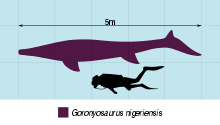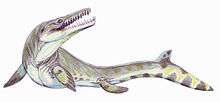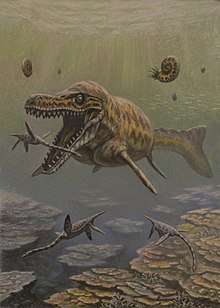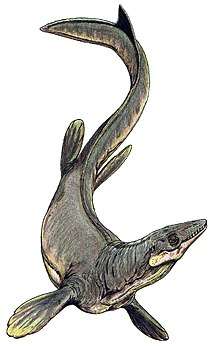Goronyosaurus
Goronyosaurus is an extinct genus of marine lizard belonging to the mosasaur family. Fossils of Goronyosaurus are exclusively known from the Dukamaje Formation of Niger and Nigeria and are Maastrichtian in age. Its fossils were first described in the 1930s as Mosasaurus nigeriensis, but subsequent remains revealed a highly unique set of adaptations that prompted the species to be reclassified as the only species of the new genus Goronyosaurus in 1972. These unique adaptations have made Goronyosaurus notoriously difficult to classify within the Mosasauridae and it is often left out of phylogenetic analyses.
| Goronyosaurus | |
|---|---|
 | |
| Diagram of the known remains of Goronyosaurus | |
| Scientific classification | |
| Kingdom: | Animalia |
| Phylum: | Chordata |
| Class: | Reptilia |
| Order: | Squamata |
| Superfamily: | †Mosasauroidea |
| Family: | †Mosasauridae |
| Genus: | †Goronyosaurus Azzaroli et al., 1972[1] |
| Species: | †G. nigeriensis |
| Binomial name | |
| †Goronyosaurus nigeriensis (Swinton, 1930) | |
| Synonyms | |
|
Mosasaurus nigeriensis (Swinton, 1930) | |
Goronyosaurus possesses unique teeth, which are unlike the teeth of any other mosasaur. Instead of the cutting teeth common among mosasaurs, Goronyosaurus has straight teeth with rounded apices adapted for smashing food.
Discovery and naming
The first mosasaur fossils in northwestern Nigeria were noted by Franz von Nopcsa in 1925, and described more completely by W.E. Swinton in 1930. the material included only isolated vertebrae, a single femur, mandible fragments and teeth were known, which Swinton described and named as the new species Mosasaurus nigeriensis. Later in the 1970s, a group of researchers from Florence, Italy, explored the Dukamaje Formation. Several localities where this geological formation was exposed were searched. Additional material recovered included more vertebrae, a partial humerus, a partial pelvis, and a nearly complete skull lacking the rear of the cranium and parts of the mandible. Because of the material being found in the same horizon of the same region of Nigeria, and the similarities in size and anatomy, these new specimens were referred to M. nigeriensis by Augusto Azzarolli and his colleagues.[1]
During the description of the new material, it was realized that there were significant differences from true Mosasaurus. As such, Azzarolli et al. named the new genus Goronyosaurus for the remains. The generic name recognizes the Goronyo District of Nigeria, where the material was found. The skull from the newly discovered material, Geological Survey of Nigeria (abbreviated as N.G.) 1, was chosen to represent the neotype of the taxon. Referred specimens include all the previously discovered mosasaur remains, excluding three significantly larger vertebrae. Casts of all the material are present in the Museum of Geology and Palaeontology of the University of Florence.[1]
Description

Goronyosaurus is a smaller mosasaur, with a body length reconstructed as 5.14 m (16.9 ft) by Soliar (1988). Previously the body had been estimated at 7.8 m (26 ft), although Soliar identified that this length was based on a false head: body ratio. This ratio is 9.1:100 is drastically different from the ratio in tylosaurines, where the head is 13.8% the length of the body.[2]
Skull
Most of the skull of Goronyosaurus is preserved in the material, although it is heavily crushed and distorted. Overall the skull is long and narrow compared to other mosasaurids, with an estimated complete length of 71 cm (28 in) and a width of only 11.2 cm (4.4 in). This ratio (6.31:1) is most similar to Tylosaurus nepaeolicus (6.18:1) among other mosasaurs, followed by Plesiotylosaurus (5.64:1) and Tylosaurus proriger (5.3:1).[2]
The snout bones of the premaxilla, maxilla and nasals are distorted and flattened laterally. The premaxilae bear strong teeth, with the anterior most tooth being placed directly behind the beginning of the snout. Large nerve foramina are placed close to the dorsal surface of the paired premaxilae. The maxillae bones are unusual for mosasaurids, as they bear teeth which extend posterior to the front of the orbit. It is uncertain exactly how many teeth there were in the maxilla due to breakage, but there is probably around eleven. The nasal bones which project between the external nares are very robust. They are approximately the same width for the entire length, and have a rugged surface, similar to tylosaurines. The nasal openings themselves are relatively small and posterior in Goronyosaurus.[2]
Discussions of the jugal bone were presented significantly in Soliar (1988), due to the supposed morphology that was completely unlike any in known mosasaurs. Azzaroli et al. (1972) proposed that Goronyosaurus has an extremely long and tall jugal, which directly contrasts with the thin slender bones of other lepidosaurs. The functional implications proposed by Azzaroli were disregarded by Soliar in 1988, due to there being no precedent for such a mechanical adaptation. The identity of the jugals was doubted by Halstead & Middleton (1982), and Soliar (1988) instead proposed that the "jugal" of Azzaroli et al. was instead a taphonomic combination of the jugal and coronoid process of the mandible. As such, the true jugal would be only around 19 mm (0.75 in) thick across a majority of its structure, similar in anatomy to Liodon.[2]
Much of the posterior skull has been crushed or broken away from the holotype. The strongly built parietals are very narrow, and are broken, although the articulation with the frontal was probably very intricate. The frontals are triangular, and articulate with the internarial bar strongly. The prefrontals are very crushed and distorted out of their original articulation, but were positioned like Tylosaurus in life. The prefrontals exclude the frontals from participating in the orbit.[2]

The pterygoid bone of the palate is preserved, and bears teeth like in other mosasaurs. The two main processes of the pterygoid are broken, because of their long and slender shape, but it probable looked similar to related taxa. The process of the pterygoid that articulates with the ectopterygoid is similar to Tylosaurus, being flattened vertically and strongly forked.[2]
Generally the occipital unit of Goronyosaurus is poorly preserved. The unit is narrow, and has tylosaurine features, as well as a unique morphology of the supraoccipital bone. Unlike on other taxa where the supraoccipital is flattened, in Goronyosaurus it has a distinct groove across its midline. The sides of the basisphenoid are unusually steep, and the vidian canal is uncovered, probably due to breakage of the thin sheet of bone that normally covers it. These features have been compared favourably to those in Plioplatecarpus, while the elongation and slenderness are similar more so to Tylosaurus.[2]
Dentition
Many isolated teeth found throughout Cretaceous Nigeria can be assigned to Goronyosaurus, because of its unique tooth anatomy. Such isolated teeth display a similar polymorphic tapering, with crowns that become blunter towards the back of the tooth row. These fit the morphology of Goronyosaurus to the exclusion of all other mosasaurs, except in the fact that such isolated teeth lack the fluted grooves of Goronyosaurus. Teeth from the front of the dentary are slightly more robust than those more posterior, but still curve gently back. Centralized teeth have very blunt cutting edges, with enamel between 150–250 ym (5.9×10−21–9.8×10−21 in) that has varying thickness while remaining shallow.[3]
Axial skeleton
Although the first two cervical vertebrae are unknown, several others from along the neck have been preserved. The neural spines are robust and the zygapophyses are well developed, but the articulation of the neural arch between vertebrae is not present. The processes that articulate with cervical ribs become stronger towards the back of the neck. Multiple dorsal vertebrae are known from along the back. Their centra begin as cylindrical, but become flattened closer to the pelvis. No neural arches are preserved in any dorsal vertebrae. Zygapophyses are weakly present, unlike in the cervical vertebrae, but the inter-arch articulations are still absent. The transverse processes are directed slightly anteriorly and dorsally, and become less pronounced towards the pelvis.[4]
Classification
Due to its unique characteristics and features, Goronyosaurus is notoriously difficult to classify and is left out of most phylogenetic analyses. Goronyosaurus was originally named within its own subfamily, Goronyosaurinae. However, this was based on the characters of the jugal now known to be incorrect. Soliar found that Goronyosaurus was within Tylosaurinae in 1988, based on a phylogeny of cranial-only characters. Mosasaurinae was collapsed into a single unit, so relationships of Goronyosaurus within it were not tested.[2] A placement within the Tylosaurinae is not necessarily correct however, as the genus was found as forming a clade with the genera Prognathodon, Plesiotylosaurus and Ectenosaurus, which would place it within the Mosasaurinae, in a comprehensive 2010 analysis of the Anguimorpha. The results from their analysis of morphology-only characters in extinct and extant taxa is shown below, collapsed to only display Mosasauridae.[5] The placements of Prognathodontini and Mosasaurini follow Russell (1967).[6]

| Mosasauridae |
| ||||||||||||||||||||||||||||||||||||||||||||||||||||||||||||||||||||||||||||||||||||||||||||||||||||||||||||||||||||||||
The clade of Goronyosaurus and Prognathodon, and the other branch with Mosasaurini, were found to be grouped by two unique (unambiguous) features, the lack of frontal bone bordering the nasal opening, and a humerus with a hooked process behind the glenoid cavity.[5] An earlier version of the 2010 analysis found a more typical phylogeny of mosasaurs, with Goronyosaurus closest to Plotosaurus in derived Mosasaurinae, and the clade Plioplatecarpinae resolved, including Ectenosaurus and Prognathodon (the latter typically a mosasaurine).[7][5] A clade of Goronyosaurus and Plotosaurus was diagnosed by the presence of teeth to the very front of the premaxilla, extension of the tooth row below and behind the orbit, frontally contacting the maxillae, the unforked shape of the contact between skull roof and supratemporal arch bones, location of the vidian canal opening moved posteriorly, absence of zygapophyseal articulations in vertebrae, and complete separation of the deltoid anc pectoral muscle crests on the humerus.[7]
Paleobiology
Diet
Goronyosaurus has a unique tooth morphology among mosasaurs. Unlike a majority of mosasaurs, which have cutting teeth, Goronyosaurus has straight teeth with a rounded apex designed more for smashing food. This means that it may have competed with mosasaurs with cutting teeth, as well as large predatory crocodilians and plesiosaurs.[8]
References
- Azzaroli, A.; De Guili, C.; Ficcarelli, G.; Torre, D. (1972). "An aberrant Mosasaur from the Upper Cretaceous of North-Western Nigeria". Atti della Accademia Nazionale dei Lincei. Rendiconti. Classe di Scienze Fisiche, Matematiche e Naturali Series 8. 52 (3): 398–402.
- Soliar, T. (1988). "The mosasaur Goronyosaurus from the Upper Cretaceous of Sokoto State, Nigeria" (PDF). Palaeontology. 31 (3): 747–762.
- Michaut, M. (2013). "Mosasaures du Maastrichtien au sud du Niger": 1–75. Cite journal requires
|journal=(help) - Azzarolli, A.; De Guili, C.; Ficcarelli, G.; Torre, D. (1975). "Late Cretaceous mosasaurs from the Sokoto District, Nigeria". Atti della Accademia Nazionale dei Lincei. Memorie de la Classe di Scienze Fisiche, Matematiche e Naturali. Sezione 2. Fisica, Chimica Geologia, Paleontologia e Mineralogia. Series 8. 13 (2): 21–34.
- Conrad, J.L.; Ast, J.C.; Montanari, S.; Norell, M.A. (2010). "A combined evidence phylogenetic analysis of Anguimorpha (Reptilia: Squamata)". Cladistics. 27 (3): 230–277. doi:10.1111/j.1096-0031.2010.00330.x. ISSN 0748-3007.
- Russell, D.A. (1967). "Systematics and Morphology of American Mosasaurs" (PDF). Bulletin of the Peabody Museum of Natural History. 23: 1–241.
- Conrad, J.L. (2008). "Phylogeny and systematics of Squamata (Reptilia) based on morphology". Bulletin of the American Museum of Natural History. 310 (310): 1–182. doi:10.1206/310.1. hdl:2246/5915. ISSN 0003-0090.
- Ross, M.R. (2009). "Charting the Late Cretaceous seas: Mosasaur richness and morphological diversity". Journal of Vertebrate Paleontology. 29 (2): 409–416. doi:10.1671/039.029.0212.
